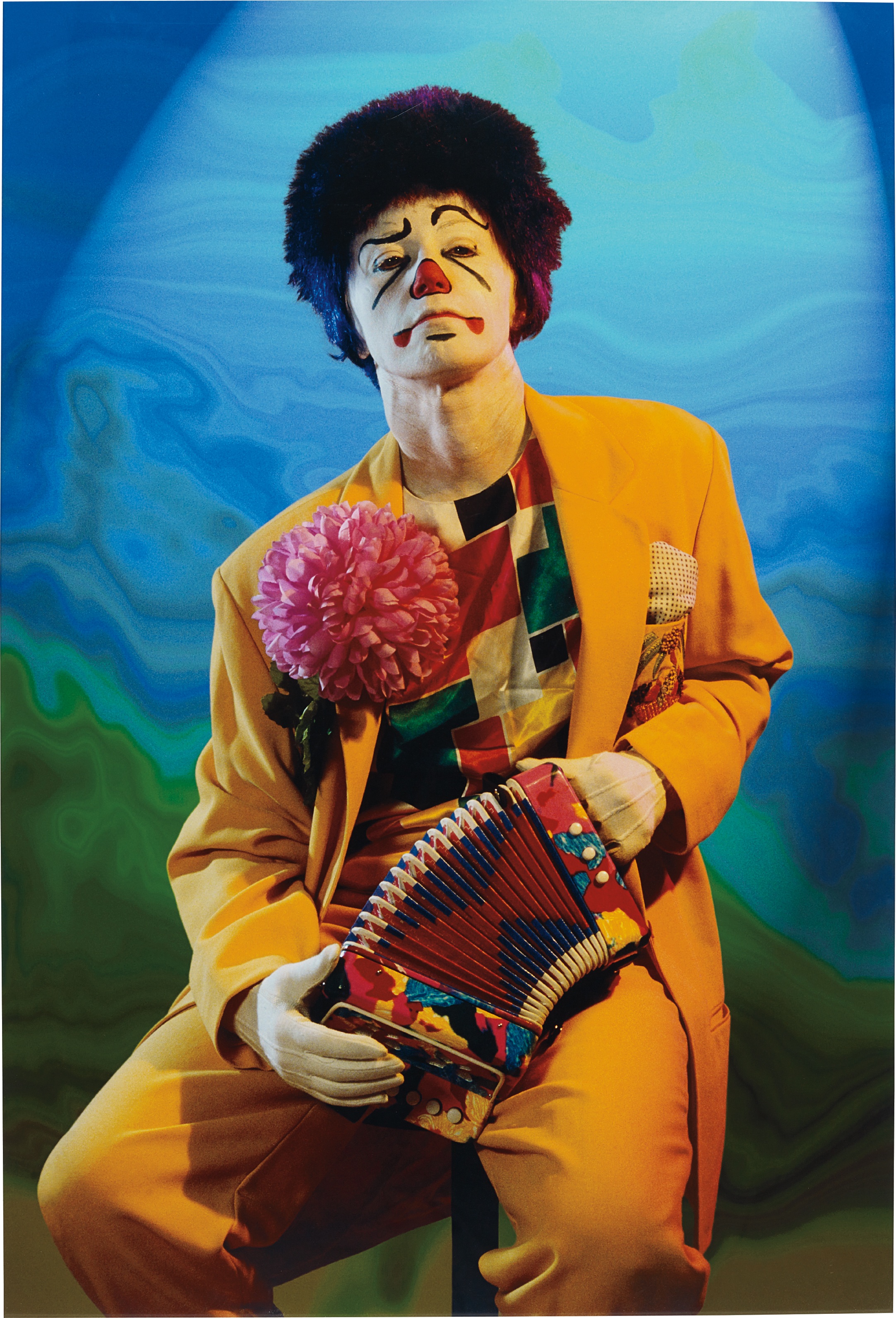

15
Cindy Sherman
Untitled #423
framed 186.7 x 127.6 cm (73 1/2 x 50 1/4 in.)
Full-Cataloguing
The Clowns series distils Sherman’s performative expression to heightened mode. As Régis Durand writes, ‘Sherman’s taste for masquerades and dressing up, the mixture of the grotesque and serious, her hysterical chameleonism, all combine to conjure the essence of clowns and clowning, hinted at in early works … The clown is the logical extension of many fundamental themes in Cindy Sherman’s work.’ (Régis Durand in Cindy Sherman, exh. cat., Paris: Jeu de Paume, 2006, p. 253). The clowns’ garish makeup and caricatured emotion enact the very mimicry that characterises her art.
If their artifice and dark comedy make a metafictional drama of her own creative project, the clowns also deepen Sherman’s inquiry into the nuances of stereotype. As though aware of his own status in collective imagination as a typecast figure of tragedy, the clown in the present lot looks grimly sardonic in his chosen part, a quizzical eyebrow competing in cartoonishness with the vast flower at his lapel. He is an eerie presence, uncanny stagelight recalling the suburban gothic of David Lynch’s red-curtained cinematic underworlds. The digitally manipulated background was an innovation, isolating the clown against psychedelic stage scenery. Sherman has spoken of the challenge of imbuing each figure with individual personality. ‘The clowns were hard because it was really difficult to feel that I was finding a character beneath the makeup that would be different in each one, so it wouldn’t seem like they were all just me with clown makeup on. That took some work.’ (Cindy Sherman in Kenneth Baker, ‘Cindy Sherman: Interview with a Chameleon,’ Walker Art Magazine, 1 November 2012).
Sherman’s studied kitsch is tinted with horror, but there is humanity even in the macabre elements of her work. For her, the clowns provided the supreme image of melancholy and comedy. They have ‘an underlying sense of sadness while they’re trying to cheer people up. Clowns are sad, but they’re also psychotically, hysterically happy.’ (Cindy Sherman in Betsy Berne, ‘Studio: Cindy Sherman,’ Tate Magazine, Issue 5, May–June 2003). She looked beyond the circus for her sources; having previously taken inspiration from characters she encountered in cinema and on the streets, for this series she made an early foray into the internet. ‘And there are just so many people who call themselves clowns. Some of them look very professional and a little too sleek … But then there are some whose websites show them performing outside on a hot, sweaty day with their makeup running, and they look like they’re wearing just any old overalls and a polka-dot T-shirt they found in a thrift store. When I found those sorts of pictures, it seemed like the variety of things I could do was sort of endless.’ (Cindy Sherman in Kenneth Baker, ‘Cindy Sherman: Interview with a Chameleon,’ Walker Art Magazine, 1 November 2012).
The inherent pathos of the clown is amplified when his façade is slipping: here, we even see the falseness of the thickened, masculine neck Sherman is wearing, just as the seams are left to show with the prosthetic noses, breasts, and teeth in her other works. His painted face bespeaks the fragility of the self-image that we all present to the world, and the taxonomic gaze that governs its assembly. The figure of the fool in Shakespearian drama often told potent social truths from behind his mask of witless entertainment: in Sherman’s sad portrait, a clown likewise tells us more about ourselves than we may want to know.
Cindy Sherman
American | 1954Seminal to the Pictures Generation as well as contemporary photography and performance art, Cindy Sherman is a powerhouse art practitioner. Wily and beguiling, Sherman's signature mode of art making involves transforming herself into a litany of characters, historical and fictional, that cross the lines of gender and culture. She startled contemporary art when, in 1977, she published a series of untitled film stills.
Through mise-en-scène and movie-like make-up and costume, Sherman treats each photograph as a portrait, though never one of herself. She embodies her characters even if only for the image itself. Presenting subversion through mimicry, against tableaus of mass media and image-based messages of pop culture, Sherman takes on both art history and the art world.
Though a shape-shifter, Sherman has become an art world celebrity in her own right. The subject of solo retrospectives across the world, including a blockbuster showing at the Museum of Modern Art, New York, and a frequent exhibitor at the Venice Biennale among other biennials, Sherman holds an inextricable place in contemporary art history.